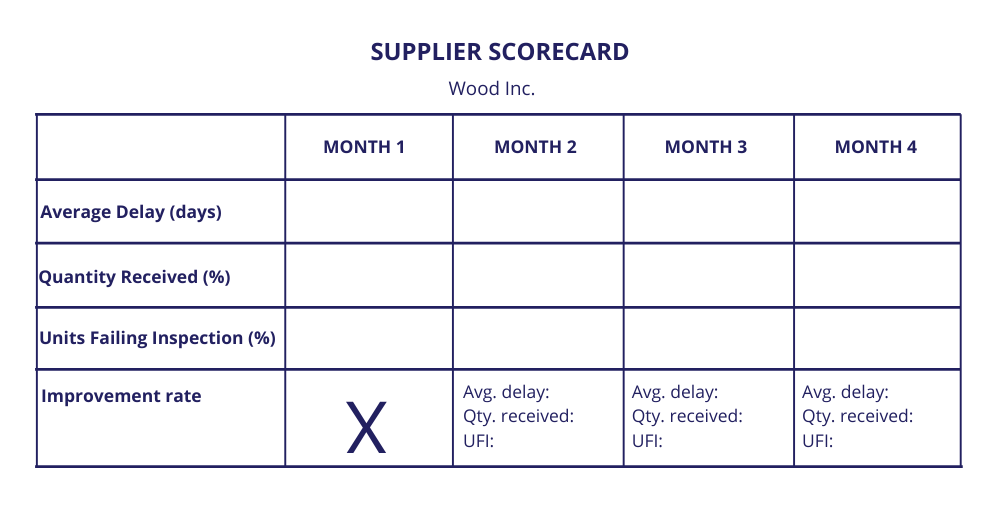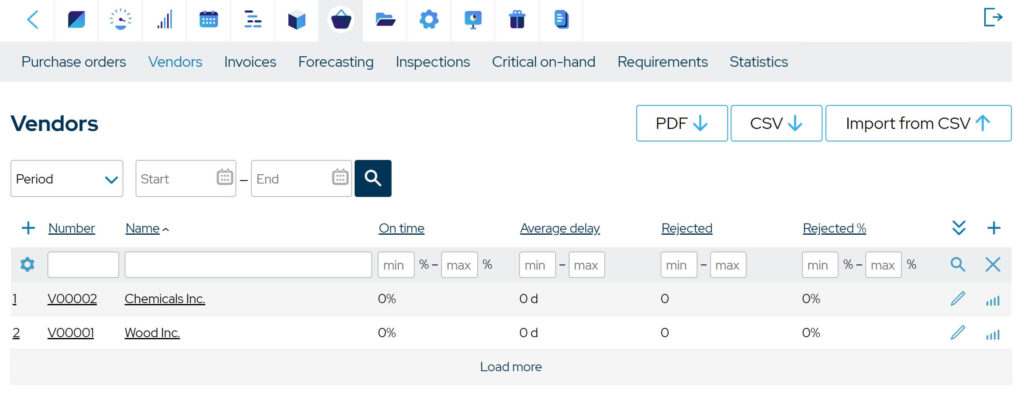Supplier Performance Management Best Practices
Supplier performance management is a vital supply chain process for any manufacturer or distributor that sources its raw materials or other items from external vendors. Effective SPM can bring a wealth of internal benefits and help foster better supplier relationships.

You can also listen to this article:
What is supplier performance management?
Supplier performance management, or SPM, is a business process focused on measuring, assessing, and improving a company’s supplier relationships. It is a subset of the larger supply chain management and procurement management. SPM includes a proactive and persistent approach to managing supplier performance with the aim to cut costs, mitigate risks, and promote continuous improvement.
Supplier performance management is geared toward ensuring that incoming stock is of high quality and purchased at the optimal cost, that suppliers align with the company’s strategic goals, and that the company is more protected against supply chain disruptions, while also helping to foster better supplier relationships.
The process includes balancing quantitative and qualitative metrics to ensure that suppliers meet quality and efficiency standards while supporting cost savings and innovation. Regular reviews and transparent communications are essential in making SPM a strategic tool for maintaining a competitive and responsive supply chain.
Benefits of supplier performance management
Supplier performance management offers a suite of benefits that can significantly enhance the procurement process and supplier relationships, boost a company’s reputation, and improve internal processes.
Achieving value for money is a primary advantage. By ensuring that companies receive goods that align with their business needs and contract terms, SPM increases the return on investment. Holding suppliers to the agreed-upon standards, SPM not only ensures quality but also fosters accountability, reducing the likelihood of subpar performance.
Risk management is another pivotal benefit of SPM. By closely monitoring supplier performance, companies can proactively manage the risks associated with their contracts. This approach is essential for mitigating issues that could otherwise lead to supply disruptions, quality defects, and safety concerns, all of which could have severe financial and reputational repercussions. Through SPM, companies gain the ability to spot root causes early and promptly initiate corrective actions. This helps further safeguard the organization’s bottom line.
SPM also contributes to improved supplier relationships. When performance metrics and expectations are clear, suppliers are more likely to understand and meet them. Open and honest discussions about performance can establish trust and transparency, leading to stronger, more collaborative partnerships. This, in turn, can lead to documented evidence of supplier capabilities, which is invaluable for future procurement decisions. By ensuring that only competent suppliers are chosen for subsequent contracts and it’s communicated, companies can maintain a high-quality supplier base.
Finally, SPM can also foster organizational efficiency by improving internal processes. It aligns various departments with vendor management goals, promoting a cohesive strategy for managing contracts and supplier engagements. This internal alignment ensures that all stakeholders are aware of their roles in supplier oversight, leading to more streamlined and effective supply chain operations.
How to measure supplier performance?
Supply chain management as a whole is a complex and dynamic process. There are essentially as many different relationships between companies as there are vendors. For this reason, conducting SPM can vary a lot in form and depending on supply requirements. It is an iterative process that is continuously improved and tweaked in order to develop a system that best serves a company’s purpose. Here are the core guidelines for creating a supplier management solution.
1. Pick the right metrics
Selecting the right key performance indicators (KPIs) to measure is crucial for aligning supplier performance with business objectives. These metrics should reflect the strategic importance of each supplier and cover a range of performance aspects.
To clarify your objectives, the metrics can be divided into four key areas – quality, delivery, cost, and responsiveness or flexibility. Let’s look at each of these along with example KPIs to consider.
- Quality KPIs measure how well suppliers align with the company’s requirements in terms of the quality of goods received, but also things like order accuracy and the quality of the overall service. Examples of quality KPIs include Defect Rate, Rate of Return, Contract Compliance (also known as Supplier Compliance Rate), Order Accuracy, Customer Service Quality, etc.
- Delivery KPIs center on assessing the supplier’s capacity to meet the delivery schedule, as well as delivery speed. Relevant KPIs include On-Time Delivery, On-Time, In-Full (a.k.a DIFOT or OTIF), Lead Time, Average Delay, etc.
- Cost metrics evaluate the financial impacts of procurement like purchase price but also the overall return on investment (ROI) of suppliers. Example KPIs in this category include Total Cost of Ownership (TCO), which accounts for all costs associated with the purchase, delivery, use, maintenance, and disposal of a product, as well as Cost per Unit, Cost Competitiveness, or Cost of Poor Quality.
- Flexibility and responsiveness metrics measure suppliers’ ability to adapt to changes in demand or unexpected shifts in the market. This includes the capacity for managing rush orders, the willingness to collaborate on problem-solving, and the overall agility in the face of supply chain disruptions. KPIs to track might encompass Volume Flexibility, which reflects a vendor’s ability to scale operations up or down, or Response Time which gauges the time at which they can accommodate new or changed orders.
It pays to consider that aside from quantitative KPIs, performance can also be measured qualitatively. This consists of metrics based on human interpretation like customer care satisfaction, or the measure by which suppliers manage to improve their performance over time. These can provide invaluable further insights into supplier performance if done consistently.
Read more about manufacturing KPIs and inventory management KPIs.
2. Create a supplier scorecard
Once the relevant KPIs are gathered, they are compiled into a supplier scorecard. A well-designed scorecard provides insights into supplier performance trends over time. This can lead to better-informed strategic decisions, such as identifying opportunities for supplier development, negotiating contracts, or even shifting to alternative suppliers when necessary.
In essence, a robust supplier scorecard is the central document of the SPM process and a strategic tool that enhances procurement efficiency and helps maintain a high-performing supply chain.

3. Measure and collect the performance
Next, the data on selected metrics is gathered and tracked. Tracking supplier performance against the criteria set in the scorecard is vital. This process presumes ensuring data quality and timeliness, which are foundational for accurate analysis. The procurement team should be trained to work consistently in accordance with the supplier performance management policy being put into place.
Many of the metrics can be measured on the fly as the procurement department and the rest of the business functions in its day-to-day. However, the automation inherent in modern procurement software can simplify gathering and compiling large parts of the required data.

4. Analyze the data
Next, the performance data is analyzed to pinpoint improvement areas and help formulate strategies for supplier development. Suppliers can be benchmarked and tiered, and statistical analyses can provide extra insight from the data.
Aside from the actionable information on supplier performance, the data should also lead to insights on how to set up a clearer SPM policy. This is instrumental in uncovering blindspots in performance measurements and reselecting metrics if necessary.
5. Communicate the results
The results of your SPM process should be communicated clearly to suppliers. Effective supplier performance management involves transparent communication with suppliers – this aids in addressing issues but also helps build collaborative relationships for future improvements.
Furthermore, making the supplier performance management process transparent for all parties involved creates ground for mutual development. The supply chain affects your whole business – that is why stakeholders outside of the procurement department should be kept in the loop by having the results of the assessments shared with them.
For example, the finance department could use the data to help determine whether or not a supplier is liable for bankruptcy. Having a clear overview of the risks related to the supply of materials could also help the company mitigate them early on.
6. Continuous improvement
As already mentioned, SPM is an iterative process. Thus, it can be a powerful tool for continuously improving procurement and supply chain processes. This chiefly means regularly reassessing performance metrics and objectives, ensuring they evolve with the company’s changing needs and market dynamics.
Implementing continuous improvement involves systematic reviews of supplier data, encouraging and enabling suppliers to innovate, and fostering an environment where feedback leads to positive change. It also means recognizing and rewarding improvements, which can motivate suppliers to maintain higher performance levels.
Supplier performance management best practices
- Foster effective supplier relationship management. Regularly monitoring and reviewing supplier interactions is key to maintaining a strong supplier base. Consistent oversight can help identify areas for improvement and opportunities to strengthen partnerships, ensuring that suppliers are aligned with your company’s quality and performance standards.
- Set realistic and achievable goals for suppliers. When establishing performance metrics, it’s crucial to consider the supplier’s current capabilities and resources. Setting attainable targets encourages suppliers to meet expectations without overstretching their capacity, which can lead to better outcomes and less strain on the supplier relationship.
- Align supplier goals with company strategy. Supplier objectives should directly support your organization’s broader strategic aims. By ensuring that suppliers understand how their performance impacts the company’s success, you can create a shared vision that drives both parties towards common goals.
- Communicate the SPM system effectively. It’s essential to ensure that stakeholders and all relevant departments are informed about the SPM processes and understand their role within it. Effective communication fosters collaboration and a unified approach to managing supplier performance.
- Manage supplier risks strategically. Identify potential risks within the supply chain and work with suppliers to develop mitigation strategies. Strategic risk management helps prevent disruptions and maintains supply chain integrity.
- Maintain a healthy supplier base. Cultivating a diverse and reliable pool of suppliers safeguards your supply chain against potential market fluctuations and supplier-specific risks. A healthy supplier base contributes to the robustness and adaptability of your overall supply chain operations.
When to look for a new supplier?
Supplier relationships are dynamic and even vendors with high long-standing performance might run into trouble and need to be replaced eventually. Here are some of the red flags to keep an eye out for that could prompt you to start looking elsewhere. However, communication is key – it might make sense to ask for an explanation and try to resolve any issues before taking more decisive action.
- Constantly late or incomplete deliveries. If the supplier’s performance in regard to lead time or incomplete deliveries starts becoming worse by the month or gets to consistently sub-par levels.
- Quality is deteriorating. It is perfectly fine to receive a few defective items once in a while, save for highly expensive materials. However, if poor quality becomes a norm rather than the odd exception, you should start thinking about finding a new vendor.
- Getting in contact is difficult. Consistently leaving phone calls and emails unanswered is a sign that the supplier is, for whatever reason, not prioritizing your business.
- Prices keep rising unrelated to market trends. Price increases unrelated to obvious changes in the market or that the vendor is reluctant to explain are red flags that might well indicate that the supplier is in financial trouble.
- Sub-par customer service. Alack of personal touch, no gratitude for the business, being repeatedly asked for the same information, complaints from your staff, etc. – bad customer service can taint even the best pricing and accuracy.
- Constant invoicing errors. Invoicing errors may point to problems in the accounts of the supplier, which is a cause for concern for all parties involved.
In the quest for a new supplier, it’s essential to seek partners who not only meet the required quality and delivery standards but also align with your company’s values and strategic goals. Look for suppliers with robust processes, a proven track record of reliability, and the agility to adapt to changing market demands.
How can manufacturing software aid in supplier performance management?
Modern manufacturing software provides companies with a wealth of tools to aid in the SPM process and gain better control over the supply chain. It allows for real-time tracking of KPIs, centralizes communication channels, and automates data collection. All this frees up valuable time for strategic analysis rather than administrative tasks.
By integrating different aspects of supply chain management, from inventory control to order fulfillment, manufacturing software like MRPeasy offers a seamless way to monitor supplier reliability, quality, and responsiveness. It becomes easier to spot trends, identify risks, and make data-driven decisions that can bolster the efficiency of the supply chain. The software’s ability to store historical data also aids in the accurate assessment of a supplier’s long-term performance and reliability.
Key takeaways
- Supplier performance management (SPM) is a strategic business process focused on evaluating and improving a company’s supplier base, aligning suppliers with business requirements, and managing supplier relationships.
- Supplier performance management offers a suite of benefits like enhancing the procurement process, mitigating supply chain risks, furthering supplier relationships, and boosting a company’s reputation.
- The SPM process can vary a lot in its setup, however, its core elements include selecting metrics to measure, systematically assessing supplier performance, corroborating and analyzing the data, communicating results, and fostering continuous improvement.
- The best practices for supplier performance management include maintaining vigilant oversight of supplier relationships, setting realistic goals that align with supplier capabilities, ensuring these goals support the company’s strategic objectives, effectively communicating SPM processes across the organization, strategically managing supplier risks, and nurturing a diverse and dependable supplier base.
Frequently asked questions
The role of Supplier Performance Management (SPM) is to systematically assess, measure, and improve the performance of suppliers. It ensures suppliers meet contractual obligations and business objectives, reducing risks and enhancing overall supply chain efficiency.
Techniques of SPM include setting clear performance metrics, using supplier scorecards for tracking, regularly analyzing performance data, maintaining open communication with suppliers, and fostering continuous improvement through collaborative efforts.
Supply Chain Performance Management (SCPM) encompasses the monitoring and improvement of end-to-end supply chain activities to increase efficiency, reduce costs, and ensure the timely delivery of products and services.
Supply Chain Management (SCM) deals with the oversight of the entire supply chain from production to product delivery, while Supplier Relationship Management (SRM) focuses specifically on managing the relationships and interactions with the suppliers who provide goods and services to the company.
You might also like: Procurement Planning – A Simple Guide




